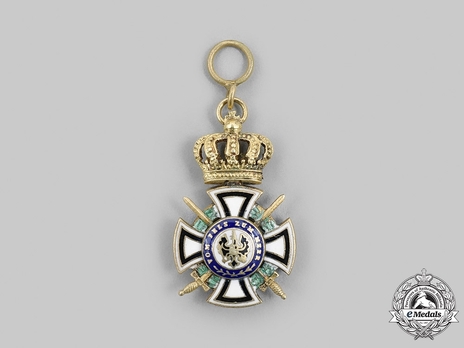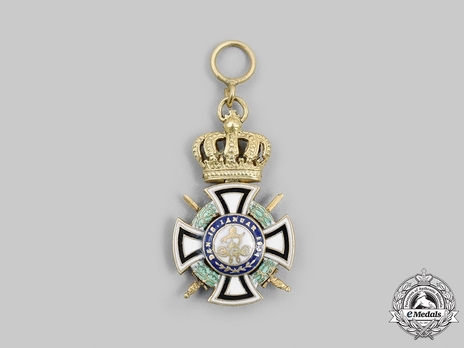Royal House Order of Hohenzollern, Military Division, Knight Miniature
CATEGORY: Miniature
SKU: 01.PRU.0111.209.01.M.000
Estimated market value:


Estimated market value:
In silver gilt, consisting of a cross pattée with black and white enameled arms, with a green enameled laurel wreath joining the quadrants, obverse with a central white enameled disc bearing a black Hohenzollern imperial eagle, within a ring of blue enamel bearing a gilt inscription of “VOM FELS ZUM MEER” with green enameled laurel branches, with gilt swords piercing the centrepiece, the reverse with a central white enameled disc bearing a monogram of King Friedrich Wilhelm IV, within a ring of blue enamels bearing a gilt institution date of “DEN 18. IANUAR 1851” with green enameled laurel branches, measuring 14.84 mm (w) x 25.18 mm (h) (inclusive of integral ring), weighing 3.2 grams, worn, otherwise near extremely fine.
On December 5, 1841, the Hohenzollern Order was established by joint decree of Prince Konstantin of Hohenzollern-Hechingen and Prince Karl Anton of Hohenzollern-Sigmaringen. The two principalities were collateral lines of the House of Hohenzollern, and cousins to the ruling house of Prussia.
On December 7, 1849, a treaty was established which handed over the Hohenzollern principalities to the Kingdom of Prussia. Following the annexation of these two principalities, the order was adopted by the Prussian ruling house. Although the principalities were annexed, the princely lines continued to award the order as a house order, entitled the Princely House Order of Hohenzollern.
In order to distinguish between the two orders, the Prussian version was called the Royal House Order of Hohenzollern. The order’s statutes were officially adopted on the King’s birthday, October 15, 1851.
The Princely House Order of Hohenzollern and the Royal House Order of Hohenzollern co-existed and were awarded independently from each other.
The Royal House Order of Hohenzollern was primarily conferred in recognition of war merit, but if a civilian or low-ranking official demonstrated exceptional merit they could be awarded an Eagle (Adler) grade. The Eagle grades were only awarded to civilians and were never awarded with crossed swords.
The motto of the order, VOM FELS ZUM MEER, translates to “from rock to sea” and references the territorial expansion from the rocky summit of Hohenzollern to the Baltic and North Seas.
The first awards were made exclusively to individuals who fought the revolution of 1848. In the second award ceremony on October 14, 1851, the Silver Honour Cross was awarded for the first time to the king’s entourage and servants. These seven silver crosses were deemed unique until 1861, when King Wilhelm awarded more and officially created the IV Class.
The order originally featured three grades, Grand Commander, Commander, and Knight.
In 1861, several grades were added to the order, including the Grand Commander Breast Star, the Commander Breast Star, and the IV Class/Member.
In 1864, crossed swords through the centre of the cross were added as an attribute that could be conferred with all regular order grades for military and war merit.
All regular order grades could also be awarded with surmounting jubilee numbers including '50' and '60'.
A miniature version of the St. John Cross could be added to the upper cross arms of order awards, which were conferred for merit in the care of sick and wounded military personnel.
In 1881, the Star of the Grand Commander was placed above the star of the Grand Cross from the Order of the Red Eagle.
In 1917, The Grand Commander could receive swords, and therefore the Grand Commander’s Cross could be worn as a decoration around the neck unless it was worn on the chain.
The Royal House Order of Hohenzollern was awarded 8,300 times during the First World War.
The Knight’s Cross with Swords was awarded eight times in 1864 and 35 times in 1866. In 1908, there were 17 living recipients. During the First World War, 7,000 were awarded. Initially only staff officers received the award, along with some submarine and torpedo commanders, as well as several aviators. The Knight’s Cross of the Order of Hohenzollern was a prerequisite for the Pour le Mérite.
After 1916, the cross was made in silver gilt. It was known to be manufactured by Godet, Wagner & Sohn, and Falkenburg & Richter.

Comments


Scroll Top